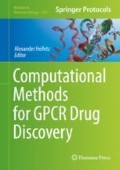Abstract
There is a substantial amount of historical ligand binding data available from site-directed mutagenesis (SDM) studies of many different GPCR subtypes. This information was generated prior to the wave of GPCR crystal structure, in an effort to understand ligand binding with a view to drug discovery. Concerted efforts to determine the atomic structure of GPCRs have proven extremely successful and there are now more than 80 GPCR crystal structure in the PDB database, many of which have been obtained in the presence of receptor ligands and associated G proteins. These structural data enable the generation of computational model structures for all GPCRs, including those for which crystal structures do not yet exist. The power of these models in designing novel ligands, especially those with improved residence times, and for better understanding receptor function can be enhanced tremendously by combining them synergistically with historic SDM ligand binding data. Here, we describe a protocol by which historic SDM binding data and receptor models may be used together to identify novel key residues for mutagenesis studies.
Access this chapter
Tax calculation will be finalised at checkout
Purchases are for personal use only
References
Marinissen MJ, Gutkind JS (2001) G-protein-coupled receptors and signaling networks: emerging paradigms. Trends Pharmacol Sci 22:368–376. https://doi.org/10.1016/S0165-6147(00)01678-3
Fredholm BB, IJzerman AP, Jacobson KA et al (2001) International Union of Pharmacology. XXV. Nomenclature and classification of adenosine receptors. Pharmacol Rev 53:527–552. https://doi.org/10.1124/pr.110.003285.1
Franchetti P, Cappellacci L, Marchetti S et al (1998) 2′-C-methyl analogues of selective adenosine receptor agonists: synthesis and binding studies. J Med Chem 41:1708–1715
Heydenreich F, Vuckovic Z, Matkovic M, Veprintsev D (2015) Stabilization of G protein-coupled receptors by point mutations. Front Pharmacol 6:1–15. https://doi.org/10.3389/fphar.2015.00082
Lebon G, Bennett K, Jazayeri A, Tate CG (2011) Thermostabilisation of an agonist-bound conformation of the human adenosine A2A receptor. J Mol Biol 409:298–310. https://doi.org/10.1016/j.jmb.2011.03.075
Nguyen ATN, Baltos J-A, Thomas T et al (2016) Extracellular loop 2 of the adenosine A1 receptor has a key role in orthosteric ligand affinity and agonist efficacy. Mol Pharmacol 90:703–714. https://doi.org/10.1124/mol.116.105007
Olah ME, Stiles GL (2000) The role of receptor structure in determining adenosine receptor activity. Pharmacol Ther 85:55–75. https://doi.org/10.1016/S0163-7258(99)00051-0
Berman HM, Westbrook J, Feng Z et al (2000) The protein data bank. Nucleic Acids Res 28:235–242. https://doi.org/10.1093/nar/28.1.235
Carpenter B, Nehmé R, Warne T et al (2016) Structure of the adenosine A2A receptor bound to an engineered G protein. Nature 536:104–107. https://doi.org/10.1038/nature18966
Ballesteros J, Weinstein H (1995) Integrated methods for the construction of three-dimensional models and computational probing of structure-function relations in G protein-coupled receptors. Methods Neurosci 25:366–428. https://doi.org/10.1016/S1043-9471(05)80049-7
Chemical Computing Group Inc. (2017) Molecular operating Environement (MOE)., Version 2015.10
Notredame C, Higgins DG, Heringa J (2000) T-coffee: a novel method for fast and accurate multiple sequence alignment. J Mol Biol 302:205–217. https://doi.org/10.1006/jmbi.2000.4042
Fiser A, Sali A (2003) MODELLER: generation and refinement of homology-based protein structure models. Methods Enzymol 374:461–491. https://doi.org/10.1016/S0076-6879(03)74020-8
Schrodinger LLC (2015) The PyMOL molecular graphics system. Version 1.8
Pettersen EF, Goddard TD, Huang CC et al (2004) UCSF chimera - a visualization system for exploratory research and analysis. J Comput Chem 25:1605–1612. https://doi.org/10.1002/jcc.20084
Munk C, Isberg V, Mordalski S et al (2016) GPCRdb: the G protein-coupled receptor database - an introduction. Br J Pharmacol 16:2195–2207. https://doi.org/10.1111/bph.13509
Kim J, Wess J, van Rhee AM et al (1995) Site-directed mutagenesis identifies residues involved in ligand recognition in the human A2a adenosine receptor. J Biol Chem 270:13987–13997
Jiang Q, Rhee AM v, Kim J et al (1996) Hydrophilic side chains in the third and seventh transmembrane helical domains of human A2A adenosine receptors are required for ligand recognition. Mol Pharmacol 50:512–521
Acknowledgments
This work was supported by the Biotechnology and Biological Sciences Research Council (grant numbers BB/M009513/1 and BB/P004245/1) and by the EU H2020 CompBioMed project (http://www.compbiomed.eu/, 675451).
Author information
Authors and Affiliations
Corresponding author
Editor information
Editors and Affiliations
Rights and permissions
Copyright information
© 2018 Springer Science+Business Media LLC
About this protocol
Cite this protocol
Potterton, A., Heifetz, A., Townsend-Nicholson, A. (2018). Synergistic Use of GPCR Modeling and SDM Experiments to Understand Ligand Binding. In: Heifetz, A. (eds) Computational Methods for GPCR Drug Discovery. Methods in Molecular Biology, vol 1705. Humana Press, New York, NY. https://doi.org/10.1007/978-1-4939-7465-8_15
Download citation
DOI: https://doi.org/10.1007/978-1-4939-7465-8_15
Published:
Publisher Name: Humana Press, New York, NY
Print ISBN: 978-1-4939-7464-1
Online ISBN: 978-1-4939-7465-8
eBook Packages: Springer Protocols

